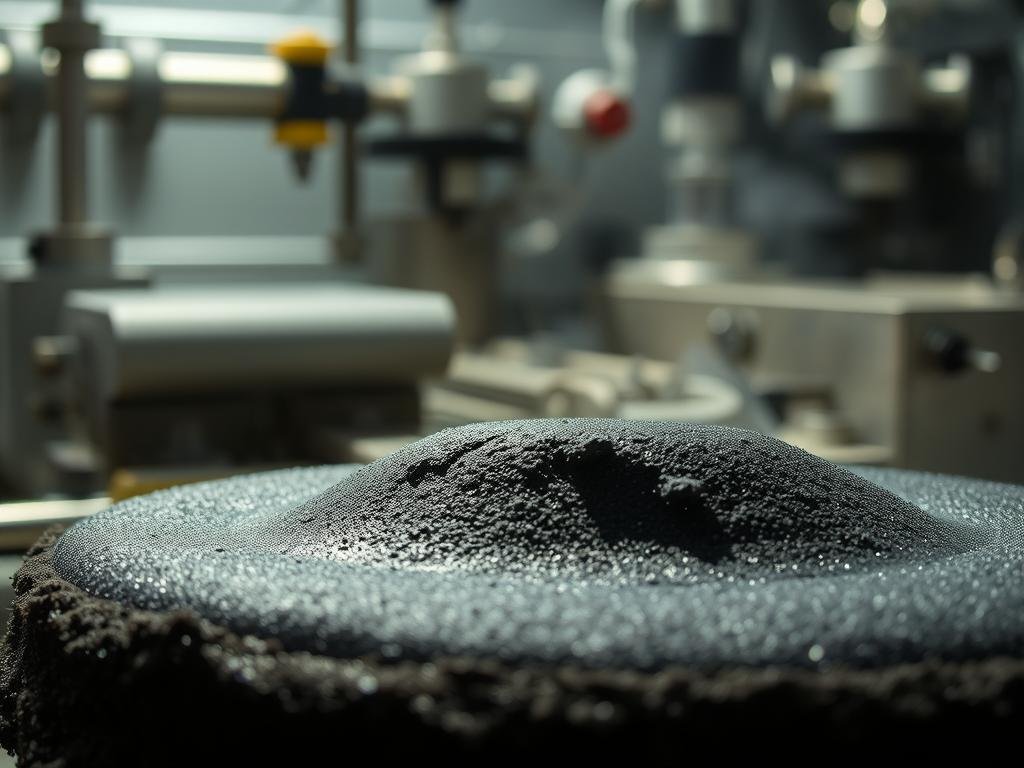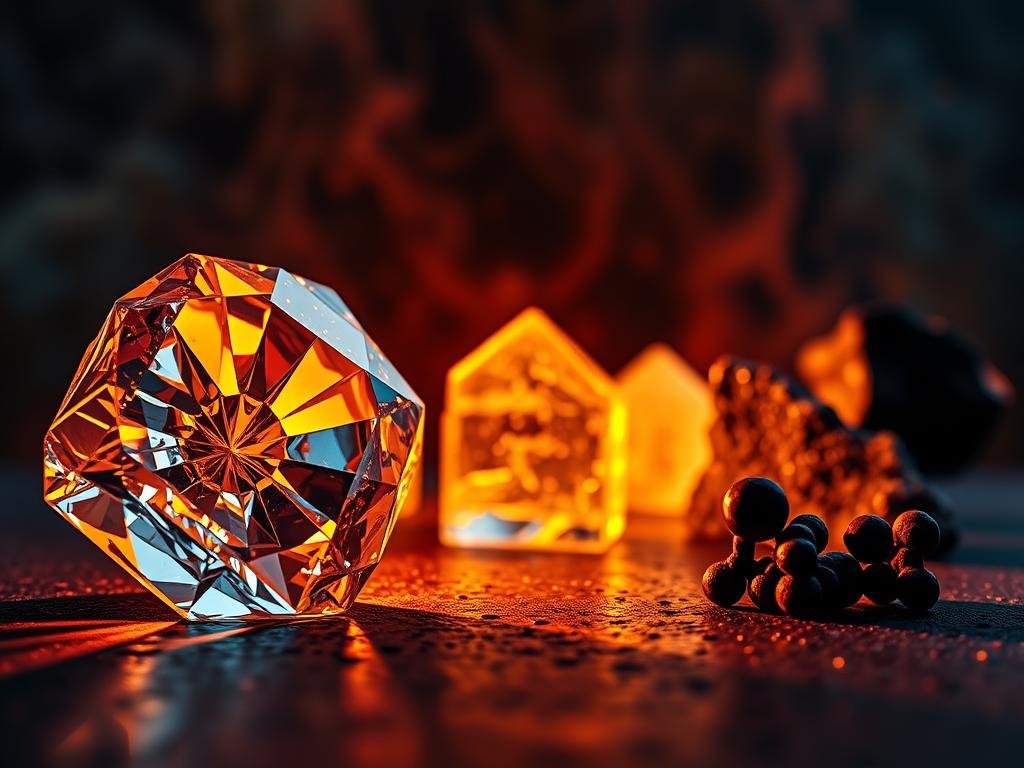La question de savoir si graphite vraiment fondre a suscité un débat scientifique intense. Le graphite, une forme de carbone, is known for its extraordinary thermal properties.
At extremely high temperatures, graphite’s behavior is not typical of many materials. Instead of melting, it can undergo sublimation, transitioning directly from a solid to a gas.
Comprendre le point de fusion of graphite is crucial for various industrial applications and scientific research. This comprehensive guide will explore the unique physical properties that give graphite its exceptionally high melting point.
Understanding Graphite’s Structure
The intricate structure of graphite, comprising layers of carbon atoms, is key to its thermal and physical attributes. This unique arrangement is fundamental to understanding graphite’s properties and behavior.
Layered Carbon Arrangement
Graphite’s structure consists of layers of carbon atoms arranged in a hexagonal lattice. This layered arrangement is crucial for its physical properties.
Covalent Bonds and Van der Waals Forces
Within these layers, carbon atoms are bonded through strong covalent bonds, requiring high energy to break. Between the layers, weaker van der Waals forces operate, allowing the layers to slide past each other easily. The combination of these bonding types creates graphite’s unique properties: strong within planes but easily separated between planes.
The Melting Point of Graphite
The melting behavior of graphite is a complex phenomenon that has garnered significant attention in materials science. Graphite’s unique structure contributes to its thermal properties.
Exact Temperature Values
Graphite’s melting point is not straightforward due to its tendency to sublimate at high temperatures. At atmospheric pressure, graphite begins to sublimate around 3000°C. The graphite melting point is typically considered in contexts where it is subjected to high pressure to prevent sublimation.

Sublimation vs. True Melting
A key consideration is that graphite tends to sublimate rather than melt under many conditions. True melting requires extremely high temperatures and high pressure. The distinction between sublimation and melting is crucial for understanding graphite’s behavior in high-temperature applications. This behavior differs from most materials, which follow a typical solid-liquid-gas phase transition.
- Graphite sublimates at around 3000°C at atmospheric pressure.
- True melting occurs under high pressure and temperature.
- The distinction between sublimation and melting is crucial for industrial applications.
Factors Affecting Graphite’s Melting Point
The melting point of graphite is influenced by several key factors.
Influence de la structure cristalline
Graphite’s crystal structure plays a significant role in its melting behavior. The layered carbon arrangement, held together by covalent bonds and van der Waals forces, affects its thermal properties.
Impact of Impurities and External Pressure
Impurities within graphite can significantly alter its melting point. Common contaminants include metals, boron, nitrogen, and oxygen, each affecting thermal properties differently. External pression also plays a crucial role, generally raising the melting point. Under extremely high pression (approximately 10-15 GPa), graphite can transform into diamond rather than melt.
| Factor | Effet sur le point de fusion |
|---|---|
| Impurities | Lower or alter melting point |
| External Pressure | Raise melting point or induce phase change |
Comparing Graphite to Other Carbon Allotropes
The comparison between graphite and diamond reveals intriguing differences in their thermal properties. While both are forms of carbon, their structural differences lead to distinct melting behaviors.
Diamond’s Melting Point
Diamond, known for its exceptional hardness, has a melting point that is notably high. At standard pressure, diamond sublimes at approximately 3800 K, a temperature significantly higher than graphite’s sublimation point.

Why the Difference Exists
The difference in melting points between graphite and diamond stems from their fundamentally different bonding arrangements and crystal structures. Diamond’s tetrahedral structure, with sp3 hybridized carbon atoms, creates a rigid three-dimensional network of covalent bonds that requires more energy to disrupt than graphite’s layered structure.
- The higher coordination number in diamond (each carbon bonded to four others) versus graphite (each carbon bonded to three others) contributes to diamond’s slightly higher thermal stability.
- Despite these differences, both materials represent extremes in thermal stability compared to most other elements and compounds.
- The comparison between these allotropes illustrates how carbon’s versatility in bonding leads to materials with remarkably different properties despite identical chemical composition.
Cette comparaison met en évidence les caractéristiques uniques de chaque allotrope, soulignant l'importance de leurs différences structurelles.
Practical Applications of Graphite’s High Melting Point
Graphite’s exceptionally high melting point makes it a crucial material in various industrial applications. Its ability to withstand extreme temperatures without losing its structural integrity is invaluable.
Industrial Uses in High-Temperature Environments
Graphite heating elements are used in industrial furnaces that operate at temperatures exceeding 2000°C. The material’s reliability in such environments is a testament to its high melting point.
Aerospace and Metallurgical Applications
In aerospace engineering, graphite composites are used for rocket nozzles and heat shields due to their ability to withstand extreme temperatures. The metallurgical industry also relies on graphite molds and dies for processes like continuous casting, where molten metals are shaped at very high temperatures.
Advanced applications include carbon-carbon composites based on graphite, which can withstand the combined thermal and mechanical stresses of hypersonic flight, further highlighting the significance of graphite’s melting point in extreme environments.
Types of Graphite and Their Thermal Properties
Understanding the types of graphite and their thermal properties is essential for optimizing their use in high-temperature environments. Graphite, known for its exceptional thermal characteristics, is utilized in various applications.
Natural vs. Synthetic Graphite
Graphite exists in both natural and synthetic forms, each with distinct properties. “Synthetic graphite, produced through high-temperature processing, often exhibits superior thermal properties compared to its natural counterpart,” as noted by industry experts. The choice between natural and synthetic graphite depends on the specific requirements of the application.
Thermal Conductivity Characteristics
Graphite’s thermal conductivity is highly anisotropic, meaning it conducts heat more efficiently within its carbon layers than between them. Key characteristics include:
- High in-plane thermal conductivity, making it suitable for heat spreading applications.
- Conductivité thermique qui varie avec la température, diminuant généralement à mesure qu'elle approche du point de fusion.
- Différents grades de graphite ayant des valeurs de conductivité thermique allant de 25 à 470 W/m·K, influencées par la pureté, la densité et la perfection cristalline.
La combinaison unique de haute conductivité thermique et de résistance à des températures extrêmes fait du graphite un matériau précieux pour des applications nécessitant à la fois transfert de chaleur et stabilité.
Conclusion
Avec un point de fusion d'environ 3650°C, le graphite est l'un des matériaux les plus thermiquement stables connus, ce qui le rend essentiel pour les applications en environnements extrêmes. La structure unique du graphite, caractérisée par des liaisons covalentes fortes au sein des couches et de faibles forces de Van der Waals entre les couches, contribue à son comportement thermique distinctif, y compris sa tendance à se sublimer plutôt qu'à fondre dans certaines conditions.
Understanding the factors that influence graphite’s point de fusion—such as crystal structure, impurities, and pressure—is vital for engineering applications. As technology advances, graphite’s exceptional thermal properties ensure it remains a critical material for solving engineering challenges. Ongoing research continues to reveal new insights into graphite’s behavior, potentially opening new applications in various fields.
